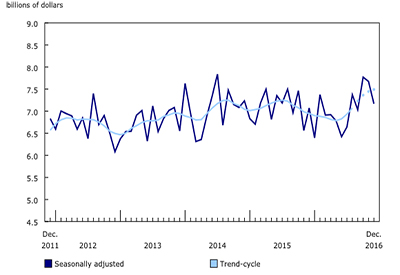Building Permits Decline 6.6% in December

February 8, 2017
Municipalities issued $7.2 billion worth of building permits in December, down 6.6% from November. Lower construction intentions were recorded for all components, led by commercial buildings and multi-family dwellings. In the residential sector, eight provinces posted declines while Ontario reported a record high.
In the non-residential sector, the value of building permits fell for the second time in six months, down 11.5% to $2.3 billion in December, led by lower construction intentions for commercial buildings. Decreases were reported in seven provinces, with Ontario, Alberta and Quebec posting the largest declines.
The value of residential building permits was down 4.1% to $4.9 billion in December. The decrease mainly stemmed from lower construction intentions for multi-family dwellings. Declines were reported in eight provinces. A record high in Ontario was insufficient to offset the declines in British Columbia and Alberta.
Non-residential sector: commercial buildings post the largest decrease
The value of commercial building permits fell 14.2% in December to $1.3 billion, accounting for almost three-quarters of the non-residential decrease. This was the second consecutive decline and was mainly attributable to lower construction intentions for retail and wholesale outlets, and warehouses. Construction intentions fell in nine provinces, most notably in Ontario and Alberta.
In the institutional component, municipalities issued $626 million worth of building permits in December, down 6.9% from the previous month. Lower construction intentions for educational facilities and medical buildings contributed the most to the decline. Seven provinces registered decreases, led by Alberta. Yukon, up $47 million from November, reported the largest increase among the provinces and territories.
The value of industrial permits fell 9.3% to $366 million in December, following two consecutive monthly increases. The decline stemmed from lower construction intentions for manufacturing structures and primary industry buildings. Decreases were posted in seven provinces, led by Quebec.
Residential sector: multi-family dwellings record the largest decline
Municipalities issued $2.2 billion worth of permits in the multi-family dwelling component in December, down 7.9% from November. The decrease was driven by lower construction intentions for rental apartments and row houses. A notable gain in apartment-condominiums in Ontario moderated the declines in eight provinces, led by British Columbia and Alberta.
The value of permits for single-family dwellings was down 0.9% to $2.7 billion in December. The largest decreases were reported in Alberta and British Columbia. Ontario, the lone province to report an increase, was up 13.0% to $1.5 billion, a fifth consecutive monthly advance.
Municipalities approved the construction of 19,589 new dwellings in December, up 1.1% from the previous month. The increase was attributable to higher intentions for single-family homes, which rose 9.9% to 7,057 new units. Conversely, multi-family dwellings were down 3.3% to 12,532 new units.
Provinces: British Columbia, Alberta and Quebec post the largest decreases
The total value of permits was down in eight provinces in December, with British Columbia, Alberta and Quebec leading the decline. Alberta, Quebec, New Brunswick and Nova Scotia reported decreases in every component.
The value of building permits in British Columbia was down 23.5% from November to $959 million in December. The decline was mainly attributable to lower construction intentions for residential buildings, following a record high for that sector of almost $1 billion ($999.5 million) in November.
In Alberta, the value of permits fell for the second consecutive month, down 24.3% to $827 million in December. The decline mainly stemmed from lower construction intentions for single-family homes and multi-family dwellings.
Following a 27.3% gain in November, construction intentions in Quebec were down 9.2% in December to $1.3 billion. Decreases were widespread among all components, led by multi-family dwellings.
Conversely, Ontario was up 7.2% in December, a third consecutive monthly increase. The gain was attributable to higher construction intentions for residential buildings, up $359 million from November.
Census metropolitan areas: Vancouver registers the largest decline
In December, the total value of building permits was down in 19 of the 34 census metropolitan areas. Vancouver reported the largest decrease, followed by Edmonton.
The value of building permits in Vancouver fell 35.2% to $568 million in December, following two consecutive monthly advances. The drop was mainly attributable to lower construction intentions for multi-family dwellings.
Following six consecutive monthly increases, the value of permits in Edmonton was down 42.9% to $332 million in December. Lower construction intentions for single-family homes and multi-family dwellings led the decrease.
In contrast, Oshawa and Kitchener-Cambridge-Waterloo recorded the largest increases, both up 123.3% over the previous month. In Oshawa, the gain was attributable to higher construction intentions for single-family homes, while in Kitchener-Cambridge-Waterloo, multi-family dwellings and single-family homes were responsible for the advance.
Annual 2016
The value of building permits totalled $84.5 billion in 2016, down 0.8% from the previous year. This was the fifth consecutive year that construction intentions have been over $80 billion. Declines were recorded in four provinces, led by Alberta. Lower construction intentions were reported in the non-residential sector, while the residential sector posted a record high.
Municipalities issued $30.4 billion worth of building permits for non-residential structures in 2016, down 4.4% from 2015 and a second consecutive year-over-year decline. Six provinces posted declines, led by Saskatchewan and Alberta, with both provinces reporting lower construction intentions in all three components.
In the residential sector, the value of permits issued for 2016 totalled $54.1 billion, up 1.3% from the previous year and continuing the upward trend that started in 2009. Gains in seven provinces were moderated by a large decrease in Alberta. Ontario led the increase, posting its highest values on record for both single-family and multi-family dwellings.
Source: Statistics Canada, www.statcan.gc.ca/daily-quotidien/170120/dq170120d-eng.htm.

















